 Contents Introduction How to Use This Book Chapter 1 The Basics: Parts of Speech 1. Nouns 2. Pronouns 3. Verbs 4. Adjectives 5. Adverbs 6.
Contents Introduction How to Use This Book Chapter 1 The Basics: Parts of Speech 1. Nouns 2. Pronouns 3. Verbs 4. Adjectives 5. Adverbs 6.
Prepositions 7. Conjunctions 8. Interjections Chapter 2 The Basics: Sentence Structure 9. Subjects 10. Predicates 11. Objects 12.
Phrases 13. Clauses 14. Types of Sentences 15. Not a Sentence: Fragments and Run-Ons 16. Sentence Variety Patterns Chapter 3 The Basics: Punctuation and Capitalization 17. Periods and Other Ending Marks 18.
Commas 19. Semicolons 20. Colons 21. Parentheses, Brackets, and Braces 22. Hyphens and Dashes 23. Italics 24.
Quotation Marks 25. Capitalization Chapter 4 Things Not to Use 26. Dead Words Anywheres , Anyways As yet 29. Wasted Words Kind of , Sort of 31. A Comma to Separate Sentences 32. Contractions Could of/Should of/Would of 34.
Conjunction to Start a Sentence Each and every 36. Abbreviations Firstly , Secondly , Thirdly, Lastly 38. Double Negatives Try and Irregardless 41. Apostrophes in Plurals 42. Comma Between Subject and Verb 43. Unclear Pronouns and Antecedents Got Instead of Have 45.
Redundancy: Repeating Yourself Chapter 5 Confusing Things Advice / Advise Affect/Effect Already/All ready Alright/All right Among/Between Bad/Badly Good/Well Compliment/Complement Data Desert/Dessert Further/Farther, Toward/Towards However and Therefore I/Me and Who/Whom Imply/Infer 60. Punctuation of Abbreviations Its/Its This/Those With Kind and Type Lay/Lie Leave/Let Less/ Fewer Like/As if Lose/Loose Only : Where to Put It Percent Principal/Principle 71. Titles: Italics or Quotes? Real/Really Rise/Raise Shall/Will Sit/Set Stationary/Stationery Than/Then That/Who/Which Theyre/Their/There To/Too/Two Whos/Whose Close/Clothes Vice versa Chapter 6 Some Grammar Issues 84. Agreement 85. Comparison 86. Dangling and Misplaced Modifiers 87.
Possessives 88. Active and Passive Voices 89. Using Strong Verbs 90. Verb Tense Consistency 91. Irregular Verb Forms 92. Linking/Action Verbs with Pronouns 93.
Parallel Structure 94. Verbals: Participles and Gerunds Chapter 7 Finishing Touches 95. Capitalization in Titles 96. Series and Lists 97. Keeping It Simple 98. Numbers: When to Spell Them Out 99.
Commonly Misspelled Words 100. Commonly Mispronounced Words 101. The Big Kahuna: Writing!!! Appendix A Glossary Index Introduction Okay. I admit it. Whenever I hear the word I used instead of me, or see the word your instead of youre, it is like hearing chalk squeaking across a blackboard! Years ago such grammatical mistakes wouldnt have bothered me, if indeed I noticed them at all. However, many years of writing, editing, and teaching English have polished up my skills and made me sensitive to such errors.
During my years as a technical writer and editor, book editor, and now English teacher, I have seen the same errors, questions, and problems come up repeatedly. I decided to put these grammatical issues together in a book that would be different from the usual grammar book. Although it does contain a review of grammar, this book is not a grammar textbook, nor is it a complete grammar reference. It is intended to address those issues that are most confusing to people when they write or speak. This book will be helpful to almost anyone who wants to write and speak (and even e-mail) correctlystudents from junior high school through college; anyone looking for that first job, a better job, or a new career; career professionals; those whose native language may not be English; and just about anyone else who has ever had a question related to grammar or writing. Arlene Miller, M.A.
Petaluma, California How to Use This Book The Best Little Grammar Book Ever contains both a grammar review (Chapters 1, 2, and 3) and common mistakes and problems in writing and speaking (Chapters 4, 5, 6, and 7). It is neither a complete grammar textbook nor a complete grammar reference; if it were, it would be called The BestBigGrammar Book Ever! I decided to focus on the topics that cause the most confusion, questions, and errors. I recommend, therefore, that the best way to use this book is to first read through it. After you have read it and know what it contains, you can use it as a reference book to remind you of what you learned. There is a short quiz at the beginning of each chapter with the answers on the following page. Take these fun quizzes to see how much you already know before you read the chapters! The first three chapters of the book present a grammar review.
Chapter 1 is all about the parts of speech. You probably learned them in grammar school, but maybe you have forgotten some of them. The parts of speech are the basic elements of the English language. Chapter 2 discusses sentence structure: What is the function of each word in a sentence? What is the difference between a sentence and a fragment? How can you write good sentences? What are phrases and clauses? Chapter 3 reviews capitalization and punctuation, those little symbols that allow you to understand the writing. You do not need to memorize all the information contained in Chapters 1, 2, and 3. However, it is helpful to have an idea of what is contained in these chapters because the same concepts come up in the other chapters of the book.
Do take time to learn any information that is contained in the Helpful Hints, which directly affect your writing and speaking. Chapter 4 begins the discussion of common problems in grammar. In this chapter you will learn some things not to do in your writing and speaking. Chapter 5 talks about confusing wordsthose words that are similar but not the sameand tells you which is which. You will never again confuse your and youre! In Chapter 6 you will find a host of other common grammar issues including how to write possessives and how to write in a parallel structure. Chapter 7 contains the finishing touches: how to write numbers, how to write series and lists, the most commonly misspelled and mispronounced words, and, finally, how to write a paragraph and a multi-paragraph letter or essay.
You are holding this book. You are now on your way to becoming a more impressive writer and speaker. Take the quizzes, read on, and impress everyone with your knowledge of grammar! If you have any comments on this book, or if you have a question about something that is not included here (and you think it should be), please contact me. I can be reached at bigwords101@ yahoo.com. Visit my website at www.bigwords101.com . Arlene Miller Conventions Used in This Book 1.
I have used boldface type for emphasis in examples and to indicate grammar vocabulary. 2. I have used boldface italics when I have used a word as itself, rather than as part of the sentence. 3. Notes are boxed with a dotted line and contain important information. 4.
Helpful Hints are boxed with a solid line and contain information that will improve your writing and speaking. 5. I have used a conversational tone in this book to make it easy to read. In some cases you might notice I have done something I have told you to avoid in order to keep a casual tone and get my point across. These choices are stylistic and have nothing to do with correct grammar. Everything should be made as simple as possible, but not one bit simpler.
Albert Einstein, (attributed)
US (German-born) physicist (18791955) Chapter 1 The Basics: Parts of Speech 1. Nouns 2. Pronouns 3. Verbs 4. Adjectives 5. Adverbs 6.
Prepositions 7. Conjunctions 8. Interjections You may remember hearing about the parts of speech way back in elementary school. The parts of speech are simply the categories into which every word in the language fits. These parts of speech are the building blocks of the English (or any) language. When people refer to the parts of speech, they mean these
Next page
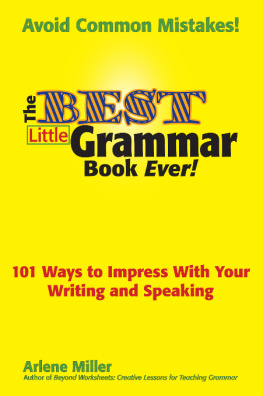
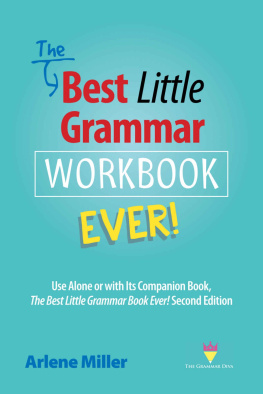

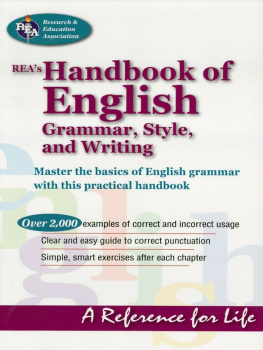
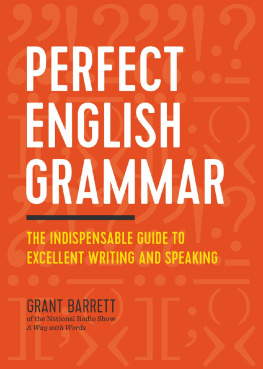
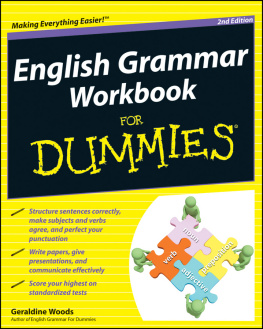
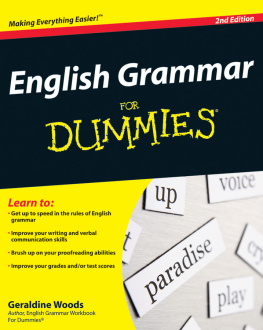
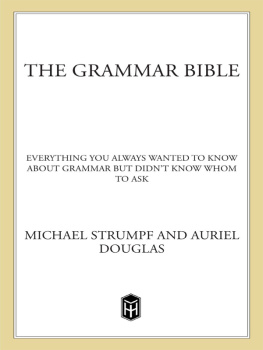

 Contents Introduction How to Use This Book Chapter 1 The Basics: Parts of Speech 1. Nouns 2. Pronouns 3. Verbs 4. Adjectives 5. Adverbs 6.
Contents Introduction How to Use This Book Chapter 1 The Basics: Parts of Speech 1. Nouns 2. Pronouns 3. Verbs 4. Adjectives 5. Adverbs 6.